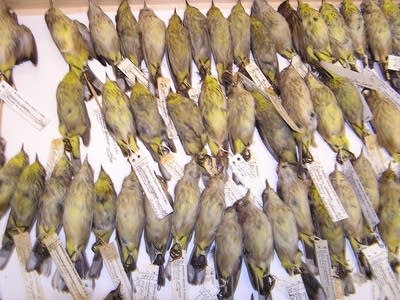When birds and buildings collide, birds lose

Robert Zink offers this bird's eye view of the problem.
You're a migrating bird relying on the stars to guide your way. A storm rolls in. The clear night turns cloudy. The stars disappear. Your bird compass is thrown off. The cloud cover forces you to descend, and you're attracted to an array of bright lights just ahead.
"They'll circle these lights. We don't know why, what's going on in their little bird brains, but maybe their trying to regain some kind of orientation," Zink says. "In the process of becoming disoriented and forced down by the cloud ceilings they run into the buildings. They run into the glass on the windows and this is a fairly significant source of mortality, although significant has yet to be defined."

Bob Zink, an ecology professor at the University of Minnesota and curator of birds at the U's Bell Museum of Natural History, is helping coordinate Project Bird Safe.
Create a More Connected Minnesota
MPR News is your trusted resource for the news you need. With your support, MPR News brings accessible, courageous journalism and authentic conversation to everyone - free of paywalls and barriers. Your gift makes a difference.
As a part of the program, about a dozen and half Twin Cities building owners from the private and public sector have joined. The building owners have agreed to reduce or turn off the exterior and interior lights in their buildings from midnight to dawn during spring and fall bird migration season.
Daniel Klem,Jr., an adviser to cities participating in the lights-out-for-birds movement in North America, is a biology professor at Muhlenberg College in Pennsylvania. For years he's worked with building owners in Toronto, New York and Chicago to reduce the risk tall buildings and glass pose to birds.
The problem is birds killed in a run in with a building might be the healthiest in the flock, according to Klem.

"Glass will take fittest member of the population as well as the unfit. So here we have this human factor that has this terrible attribute about it that can harm our populations and we're just too unsophisticated at this point to tell how much."
Klem has worked with the city of Chicago where bird advocates say they now have a 100 percent participation rate by building owners. Every night during migration they turn off outside display lights on buildings 20 stories or higher. The result, the advocates claim, is thousands fewer birds are killed.
Stillwater resident Joanna Eckles, one of coordinators of Project Bird Safe, says the goal in the Twin Cities is broader. Eckles encourages owners to turn off both exterior and interior lights.
"(We are) working with building owners, managers, employees, tenants of buildings to get lights turned out or minimized as much as possible to allow the birds migrating through to pass over without getting trapped in urban core," she says.

The assumption is saving birds is a good thing, since some species are suffering. Audubon Minnesota director of conservation Mark Martell says population declines among some species common to Minnesota are dramatic.
"Meadowlarks, for example, at one time were very very common and there seems to be a decline in those birds. Twenty years ago you couldn't step outside in the Twin Cities without seeing nighthawks overhead and I haven't seen a nighthawk in the Twin Cities in a long time," he says.
Besides turning off lights another part of the solution may include making a different kind of glass for buildings, says Muhlenberg College biologist Daniel Klem.
"Almost like a one-way glass where you inside your home or workplace, you look out and see the world as we do now. But if you're looking at the glass or window from outside you're seeing patterns that birds are able to pick up that is signal to recognize it as a barrier and avoid it."
Tall, glass covered city buildings are but one risk to North America's migratory bird population. Collisions with vehicles appear to kill 70 million birds a year, according to the University of Minnesota's Robert Zink. He says cats kill a million birds a day in the U.S. alone. The bird fatality rate from buildings is unknown, but could be higher.
The turn-out-the-lights effort may be critical to helping sustain threatened bird populations, researchers say.
